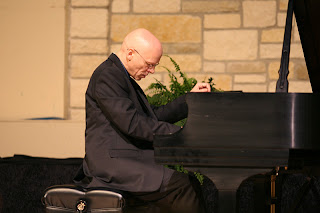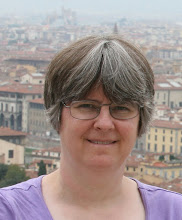As promised, here's my initial summary of the conference I attended last week, along with another photo from it (which might make it into my SoFoBoMo book). I sent this out to a bunch of Regent College friends, hence all the Regent references.
.jpg)
Regent Alumni Enjoy a Great Banquet at the Transforming Culture Symposium in Austin
Perhaps it was the lure of seeing and hearing Eugene Peterson and Jeremy Begbie again, or the desire to support our fellow alum David Taylor (ThM '00) whose brainchild this conference was, or simply the need to get away from the unusually long winter of 2008 in Vancouver. Whatever the reason, 25 Regent alumni and current faculty/staff/students congregated in Austin, Texas, making up about 4% of the 600+ attending the Transforming Culture Symposium from April 1-3, 2008.
The conference -- aimed at pastors, church leaders, and artists, and led by David and his collaborator Larry Linenschmidt -- put forth a "vision of a relationship between the church and the arts that is theologically informed, biblically grounded, liturgically sensitive, artistically alive, and missionally shrewd."
It sought to address six key themes and questions: 1. THE GOSPEL: In what way is art a gift, a calling, and an obedience? 2. THE PASTOR: How is the pastor an artist and the artist, a pastor? 3. THE WORSHIP: How can our actions and spaces be artfully shaped? 4. THE ARTIST: What is an artist and how do we shepherd these strange creatures? 5. THE DANGERS: What are the dangers of artistic activity? 6. THE FUTURE: What is a vision of the evangelical Church in the year 2058?
Food metaphors were in plentiful supply.
We were treated to a tasty smorgasbord of talks on these questions by the six plenary speakers: Andy Crouch (author, editorial director for The Christian Vision Project at Christianity Today), Eugene Peterson (author, pastor, Regent professor emeritus), John Witvliet (director of the Calvin Institute of Christian Worship, former Regent Summer School professor), Barbara Nicolosi (screen-writer, consultant, film critic), David Taylor (writer, arts pastor extraordinaire), and Jeremy Begbie (musician-theologian, founder of Theology Through the Arts, former Regent Summer School professor).
THE GOSPEL
Andy talked about art as those aspects of culture that cannot be reduced to utility. Art is a free response to grace; it is play. Like play, pain is also useless. They both must come together in art. Play that doesn't acknowledge pain can become escapism. Pain without play and grace can lead to sadism. Only in Christ can we make art with full awareness of the pain that exists. Andy also pointed out that art cannot be done alone; it requires community.
THE PASTOR
Eugene was quintessentially Eugene. He told us stories. Stories of three artists who had shaped his pastoral identity by teaching him the difference between a vocation and a job description. There was Willy, the painter, who made a prophetic portrait of Eugene looking gaunt and grim, as he might look in 20 years if he insisted on being a pastor; Willy said "the church will suck the soul out of you" (Eugene didn't take his advice, but kept the portrait as a cautious reminder).
There was Gerard, the architect who came and worshiped for a year with the newly forming church community in Eugene's basement, so that he could listen to who they were and what they needed in a new church building (simple, honest, beautiful).
There was Judith, the weaver, who felt "lucky" to hear the story of David preached for the first time in her life (she had a "beginner's mind, a child mind" as the Buddhists say). She would weave Eugene tapestries of things she'd heard him say. She eventually became a Christian, but none of her artist friends could understand what she saw in it.
THE WORSHIP
With many beautiful projected images, John introduced us to three spiritually nourishing and culturally crucial constraints on art for use in public worship assemblies. 1. It must be corporate, resisting isolation and elitism. 2. It must help people pray, resisting both sentimentality and the temptation to make the art an end in itself. 3. It must aid in perceiving the glory and beauty of the triune God, resisting idolatry.
THE ARTIST
Barbara, the only Catholic on the panel, and by all accounts the "spiciest" (she had us in stitches with her hilarious and sometimes irreverent quips), spoke first of some of the functions of beauty: its wholeness brings rest, its harmony brings joy, and its radiance brings fulfillment. The beautiful makes us feel small and humble. We have a responsibility as the church to provide art so that people can get in touch with their creatureliness and be okay with it.
Barbara told us how to recognize real artists: their artistic talent shows up early; their work has emotional power; they connect personally to the audience/viewers; their work has a freshness, a prophetic voice; and they are obsessed with details of form. She countered the common misperceptions that artists are crazy or lazy.
Finally, she outlined the "crosses" artists have to bear: loneliness, rejection, instability, entrepreneurism, having to collaborate with people, and the burden of success.
THE DANGERS
David talked about his passion to see artists as fully integrated persons, mature, and alive to God. To that end, he discussed six dangers of artistic activity in the church: bad art (e.g., cliché, melodrama, impersonal), super-saturation (too much of a good thing), the stubborn ossification of tradition (which he called "estancandose tercamente" -- Spanish for "getting stuck stubbornly"; also known as "the dead faith of the living"), the utilitarian subjugation of art (to worship or evangelism), art as a form of distraction (escape into feeling, entertainment), and immaturity (lack of self-control, manipulation, being ruled by fear).
David gave us three qualities of healthy artistic growth: it is relationally ordered (pastors relating to artists, older to newer generations, home culture to distant cultures), contextually relative (artistic excellence is when a work accomplishes the purpose for which it was created, as Nicholas Wolterstorff said), and organically rhythmed (seasonal, balancing "festal muchness" with "cleansing simplicity").
THE FUTURE
Finally, Jeremy was charged with predicting what the next 50 years of art in the church would look like. He treated us to an amazing tour-de-force in his typical style, a combination of lecture and performance (he's a fine concert pianist, in addition to sharing initials with J.S. Bach). Using the final movement from Prokofiev's 7th Piano Sonata, and bits of other works, Jeremy demonstrated "hopeful subversion," starting not with where we are now, but rather with a vision of God's future and working backward from there.
His main points were: 1. The Spirit unites the unlike (e.g., people hearing one another in their own tongues at Pentecost). 2. The Spirit generates excess (the same "festal muchness" David talked about; the New Creation is not merely a restoration of balance to the world but vastly exceeds the Garden of Eden). 3. The Spirit inverts (the rich become poor, and the poor rich). 4. The Spirit exposes the depths to which Christ has gone and the depths of who we are (as opposed to sentimental solipsism which avoids darkness). 5. The Spirit recreates (the Resurrection was the first day of the New Creation) 6. The Spirit improvises (the new heaven & new earth is surprisingly, endlessly new). For many, God is dull because he seems so "ordered" -- all word/logos and no spirit. Jeremy invited us to embrace "non-order" (as distinct from disorder), which is the realm of laughter and the Spirit.
Bryan Brown and his team led us in worship that reinforced the principles being espoused in the conference. There was beauty, simplicity, and honest grappling with darkness. The unifying theme was the colors of the rainbow (a work of art by the triune Creator). Each day of the symposium, the lighting was changed to highlight two different colors from the spectrum. We sang some very Regent-ish songs, including Eugene's favorite "St. Patrick's Breastplate" (complete with all the weird rhythms and versification). Visual art, music, dance, and drama were all interwoven with excellence.
In between the keynote lectures and worship times, there were testimonies by practicing artists. There was also a cornucopia of breakout sessions covering everything from The Care of Artists, to Drama, Architecture, Cross-Cultural Mission, Forming an Arts Ministry in the Church, etc. (Recordings of all the plenary lectures and many of the breakout sessions will be available on the conference website at some point in the future.)
In addition to the four plenary speakers with Regent ties, there were also Regent connections with several of the breakout session leaders: Dal Schindell participated in the session on "Seminaries & the Aesthetic Formation of Pastors." Luci Shaw (writer-in-residence and alum) presented "Called & Completed: A Vision for the Vocation and Maturing of the Artist of Faith." Sandra Bowden (whose work has been exhibited in the Lookout Gallery) spoke on "Visual Homiletics: How Can We Preach to the Eye as well as to the Ear?"
As David clarified during one of the Q&A sessions, the title of the symposium meant not that we aim to transform the culture by our art, but that God is in the business of transforming culture, and we are blessed and called to participate in that. What an awesome privilege it was to participate in what I truly believe will be looked back on in generations to come as a key moment in the growing renewal of the arts in the evangelical church that God is in the midst of accomplishing. A tasty morsel indeed!
.jpg) I'm back from a few days in Atlanta, where I took the last of my photos for my SoFoBoMo book. Still need to go through and select out the 35+ best ones for the book, but once I've weeded out the bad ones, I have decided on my further selection criteria: No theme whatsoever, simply a look at the breadth of (sometimes extraordinary) experiences I have in an ordinary month. I'm going to go for variety as much as possible.
I'm back from a few days in Atlanta, where I took the last of my photos for my SoFoBoMo book. Still need to go through and select out the 35+ best ones for the book, but once I've weeded out the bad ones, I have decided on my further selection criteria: No theme whatsoever, simply a look at the breadth of (sometimes extraordinary) experiences I have in an ordinary month. I'm going to go for variety as much as possible..jpg)
.jpg)
.jpg)
.jpg)
.jpg)
.jpg)
.jpg)
.jpg)
.jpg)


